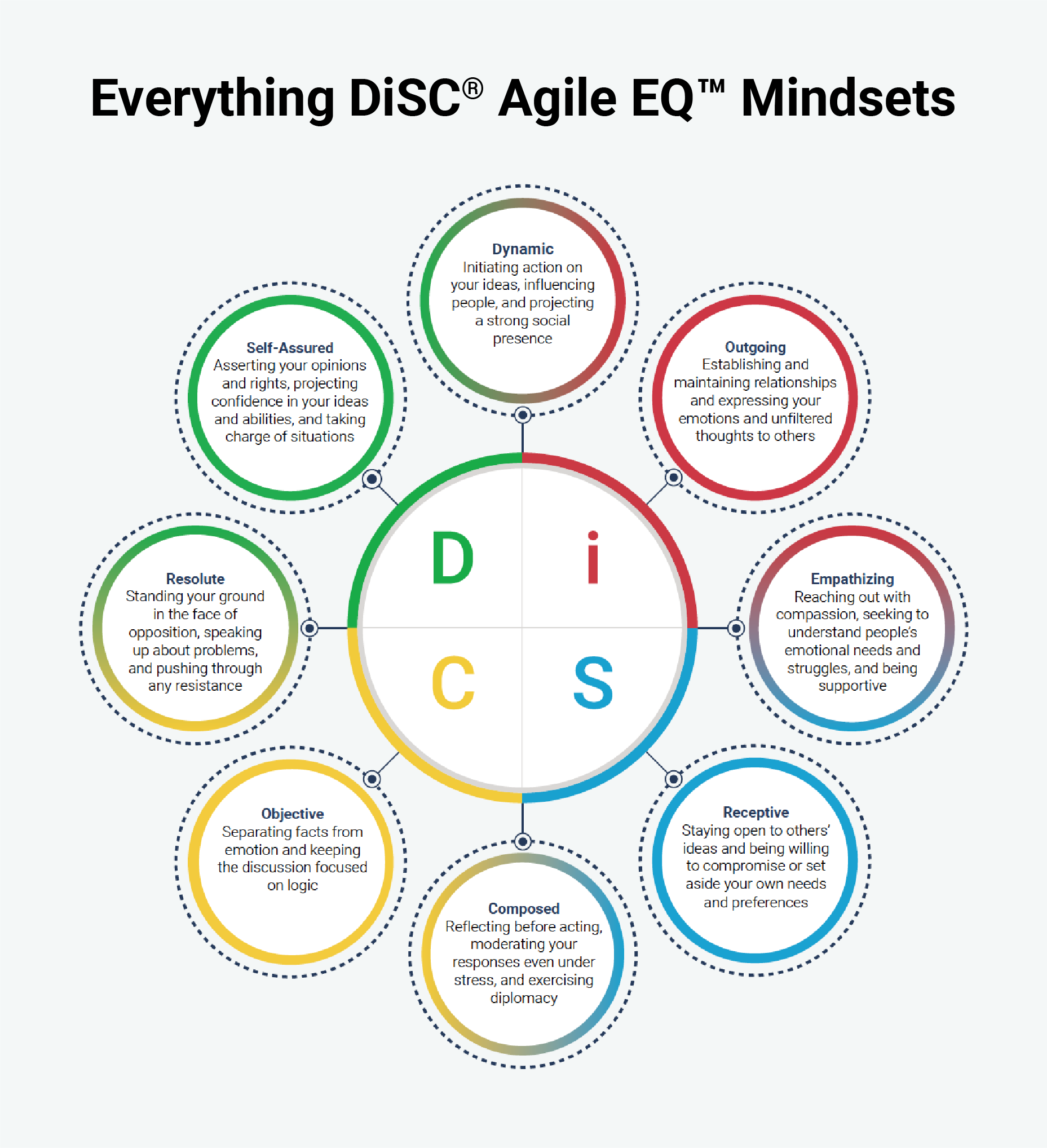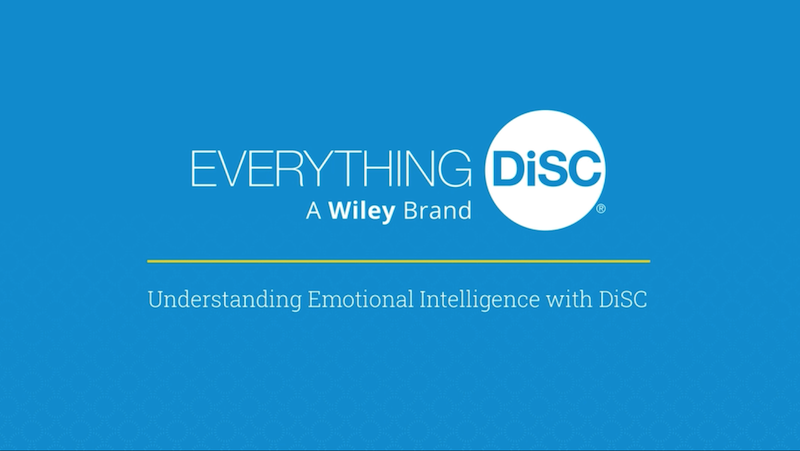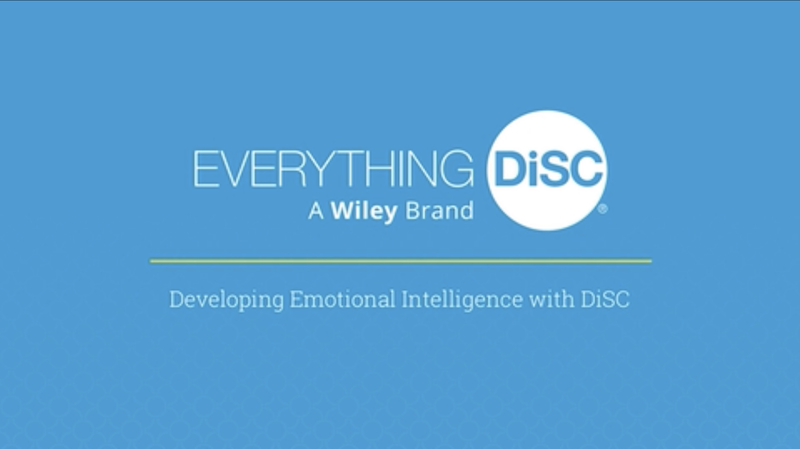Emotional Intelligence (EQ) and Emotional Agility

Key Takeaways
- Emotional intelligence is not just something innate you either have or don’t. It is a skill you can develop with practice.
- Agile emotional intelligence goes beyond self-awareness to help you stretch into mindsets beyond your default setting when the situation calls for it.
- DiSC offers tools for practical skills development in emotional intelligence and emotional agility.
Why do some people have a knack for keeping calm? Why are some so persuasive? How is it that some people can maintain focus on a goal while others tend to lose steam? Why do some people embrace risk and others minimize it?
We all have particular mindsets that come naturally to us, so much so that they become automatic. But when you over-rely on the tendencies that are comfortable to you, it can distort the way you look at the world. And because other points of view take more effort, you might not recognize when a situation calls for them.
Emotional intelligence (EQ) helps you understand your natural mindsets and those of others. It helps you find the right response to complex interpersonal situations.
Emotional intelligence definition
Emotional intelligence is sometimes referred to as “EI” or “EQ,” which stands for “emotional quotient,” to parallel the language of IQ, or intelligence quotient. You might also hear people discuss “emotional literacy,” indicating skill at reading and understanding the emotions of self and others. The terms “emotional intelligence” and “EQ” gained popularity in 1995 with the publication of psychologist Daniel Goleman’s book Emotional Intelligence: Why it can matter more than IQ.
Our definition of emotional intelligence is from a report by Wiley titled Agility Unlocked: Revealing the connection between agility and emotional intelligence (PDF). They share their research showing that in a survey of 2,500 professionals:
- 95 percent said that EQ is at least as important at work as IQ
- 41 percent left jobs in the past because they were working with people who had low EQ
- 86 percent of leaders said emotional intelligence is more important to them now than it was five years ago
Developing your EQ is important to career success.
What is “agile” emotional intelligence?
Companies today must respond to challenges more quickly than ever. That’s why so many organizations are adopting agile practices, like flattening decision-making hierarchies, introducing agile project management, or emphasizing flexibility in hiring.
However, too many companies focus on making their processes more agile, but neglect to do the same for their people. Smart companies do both, because you can’t be an agile organization without agile workers.
Agile processes acknowledge that you can’t predict every possible outcome of a project. “Responding to change over following a plan” is one of the four pillars of the Agile Manifesto. You can start out with a plan, but rather than just sticking to it when other factors change, you pivot and adjust along with the situation.
Likewise, you can’t predetermine a personal interaction. You can decide what is the best approach to start with, but if you see that the interaction is going down the wrong path, you must be able to stop and find a new path.
The key to developing an agile workforce is emotional intelligence (EQ), according to Agility Unlocked (PDF). Agile culture demands people who are resilient, proactive, and collaborative. It demands clear communicators, keen listeners, and lifelong learners. These are all qualities that can be practiced and developed through EQ training.
Agile emotional intelligence, or emotional agility, goes beyond self-awareness and puts EQ to work in daily real-life situations. It teaches people to practice stretching into EQ mindsets other than their default ones, and to do so even when it's difficult.

Examples of emotional agility or agile emotional intelligence
Think back to an interaction you had recently. How was your response based in instinct? How would you have responded if you approached it from a different attitude? Consider these scenarios:
Sara
Sara’s natural mindset is empathizing. Her coworker Charlie is stressed about a last-minute project that needs to be done over the weekend. He talks to Sara about how overwhelmed he is, and asks if she can do the project instead. Sara’s instinct may be to agree to take on the project because doing so will lessen Charlie’s stress. As a naturally empathetic person, she has compassion for what others are going through and wants to find ways to support them. So Sara may take on this extra work even if it is not her job to do so, or she has important plans during the weekend. This could lead to resentment on Sara’s part, and Charlie might start dumping more of his work on her. There are many subtle ways this interaction could contribute to unhealthy team dynamics.
If, during the conversation, Sara decided to approach it from an objective mindset, she wouldn’t suddenly lose her natural empathy for Charlie. Rather, she would recognize and acknowledge it, but also realize that the project is Charlie’s to do and explain this to him, moving the conversation into a space where they can both look at the situation rationally.
Or if Sara adopts the self-assured mindset, she may respond to Charlie’s request with a kind but firm answer such as, “No, it doesn’t make sense for me to do this project, but here’s what we can do.…” Sara could then guide Charlie through how to get the information and resources he needs to feel confident completing the work on his own. By coaching Charlie through developing a plan, Sara is still able to help him feel less stress (something her empathizing self values). There are ways to help beyond doing his work for him.
Arun
Arun’s natural mindset is receptive. He is presenting a new idea to his team at their weekly meeting. It’s an idea he has researched a great deal and that he knows is likely to succeed. When he brings it up at the meeting, his coworker Eva suggests a different idea, just off the cuff. Even though Arun has put a lot of work into his idea, and the one Eva proposes doesn’t make much sense to him, his receptive disposition leads him to stay open to it. So, when the team’s discussion shifts toward Eva’s idea, Arun doesn’t push back. Thus, Arun’s idea doesn’t get the consideration it deserves, and the team chooses a direction that won’t be as successful.
If Arun has been practicing emotional agility, he can read what’s happening in the room, and reach beyond his instincts. Perhaps he pivots to a resolute mindset, telling himself not to get distracted by other ideas right now, to stay on message. He still believes that other viewpoints are important, but he owes it to his idea to make sure his team considers it first.
Arun’s EQ work can start in advance, too. If Arun has an understanding of his natural tendencies, he can go into the meeting with a mindset that suits the situation and his goals. He may recognize that pitching a new idea often calls for being dynamic. Before the meeting, he reviews what he knows about his teammates and spends time putting together an argument that he knows will excite them. Perhaps he starts with a story to get them all interested. He brings engaging handouts or slides. He presents his idea with passion and energy, making it hard for them not to see its potential.

EQ and DiSC
Everything DiSC® Agile EQ™ combines the personalized insights of DiSC with emotional intelligence development. Rather than some elusive quality either you have or you don’t, EQ is a skill—and like any skill, you get better with practice. Agile EQ participants will discover their EQ strengths, recognize their EQ opportunities, and learn to stretch outside their comfort zone, empowering them to meet the demands of any situation.
Agile EQ puts less emphasis on diagnosis and theory, and more emphasis on giving people the tools they need to stretch beyond their own DiSC region. The assessment measures each participant’s comfort with eight EQ mindsets, and the 26-page profile (PDF) provides concrete steps to take to practice navigating outside their comfort zone.
Agile EQ is practical and systematic in a world that’s often ambiguous. Not only that, but it’s highly personalized. The profile shows a participant’s EQ strengths along with “effort meters” showing how challenging each mindset is for that person. Two people may share a DiSC style but have very different effort meters, based on their EQ.
It may never feel completely natural to be very outgoing or composed or self-assured, if that’s not how you’re built. But Agile EQ shows how to venture into those mindsets, whenever the situation demands it. By looking at EQ through the lens of mindsets rather than immutable personality traits, Agile EQ shows when your thinking may need to shift, even if your values don’t.
Emotional intelligence videos
Learn more about EQ and DiSC in these videos from Everything DiSC:
Posted 07/15/2020, Last Updated 01/30/2025









